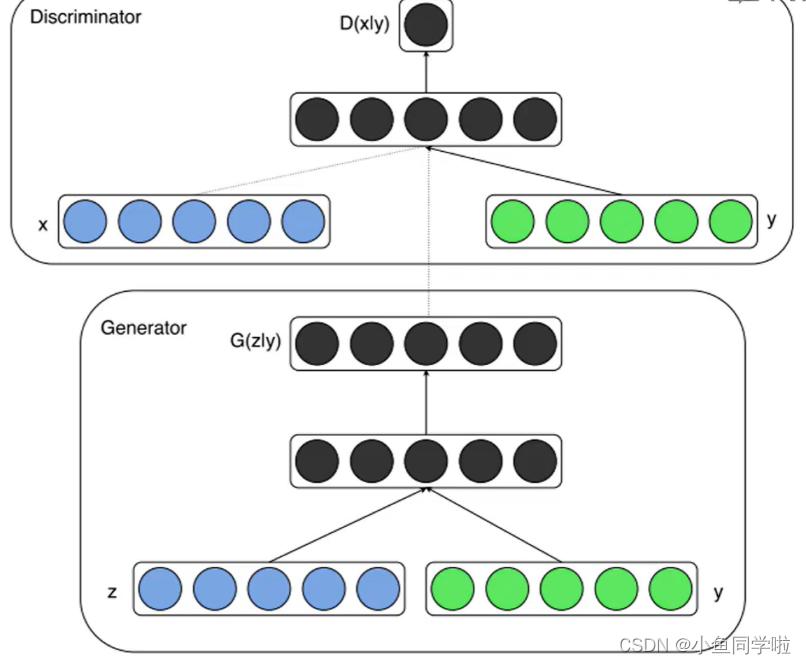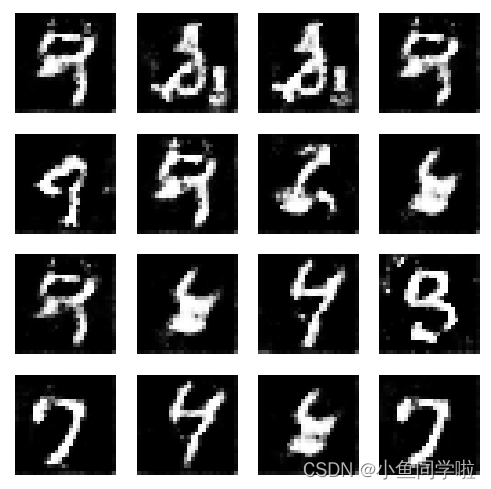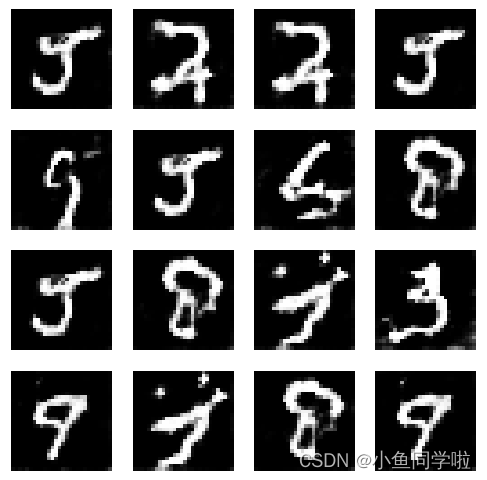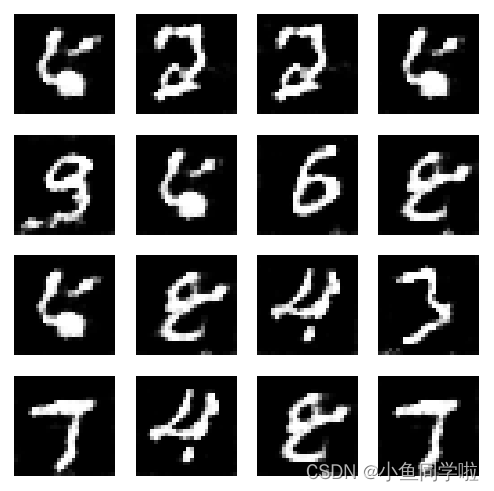CGAN理论讲解:
论文地址:https://arxiv.org/pdf/1411.1784.pdf
说CGAN之前,先让我们聊一聊原始GAN的缺点,毕竟CGAN就是为了解决原始GAN的问题而出现的。原始GAN生成的图像是随机的,不可预测的,无法控制网络输出特定的图片,生成目标不准确,可控性不强。针对原始GAN不能生成具有特定属性的图片的问题,Mehdi Mirza等人提出了今天我们所要讲的CGAN(conditional gan),其核心在于将属性信息y融入生成器和判别器中,属性y可以是任何标签信息,例如图像的类别、人脸图像的面部表情等。
CGAN将 无监督学习 转为 有监督学习,使得网络可以更好的在我们掌控下进行学习。
CGAN损失计算公式:

从公式看,CGAN相当于在原始GAN的基础上对生成器部分和判别器部分都加了一个条件y(关于原始GAN的公式可以参见:【对抗网络】Gan的基本公式详解-CSDN博客)
CGAN整体架构:

CGAN的中心思想是希望可以控制GAN生成的图片,而不是单纯的随机生成图片。具体来说,Conditinal GAN 在生成器和判别器的输入中增加了额外的信息条件(如上图的绿色信息条件y),生成器生成的图片只有足够真实且与条件相符,才能够通过判别器。
运行结果:
我们指定生成的数字:[ [5, 2, 2, 5], [ 9, 5, 6, 8], [5, 8, 4, 3], [7, 4, 8, 7] ]



epoch=0 epoch=5 epoch=10
导入的库:
import torch
import torch.nn as nn
import torch.nn.functional as F
from torch.utils import data
import torchvision
from torchvision import transforms
import numpy as np
import matplotlib.pyplot as plt
transform = transforms.Compose([
transforms.ToTensor(),
transforms.Normalize(0.5, 0.5)
])数据准备(这里要用独热编码将标签转换成张量形式):
# 独热编码,将标签转变成张量形式
def one_hot(x, class_count=10):
return torch.eye(class_count)[x, :]
dataset = torchvision.datasets.MNIST(
'data', train=True,
transform=transform,
target_transform=one_hot) # target_transform 是一个在数据加载过程中用于对目标(标签)进行预处理的参数
dataloader = data.DataLoader(dataset, batch_size=4, shuffle=True)生成器的初始化部分:
# 生成器的初始化部分
# PS:1.输出层要用Tanh激活函数 2.使用batchnorm,解决初始化差的问题,帮助梯度传播到每一层,防止生成器包所有的样本都收敛到同一个点
class Generator(nn.Module):
def __init__(self):
super(Generator, self).__init__()
self.linear1 = nn.Linear(100, 128 * 7 * 7)
self.bn1 = nn.BatchNorm1d(128 * 7 * 7)
self.linear2 = nn.Linear(10, 128 * 7 * 7)
self.bn2 = nn.BatchNorm1d(128 * 7 * 7)
# 这里是反卷积,stride=2即让图像放大2倍,padding=2即往里缩小两格。
self.decon1 = nn.ConvTranspose2d(in_channels=256, out_channels=128,
kernel_size=(3, 3),
stride=1,
padding=1) # (128, 7, 7)
self.bn3 = nn.BatchNorm2d(128)
self.decon2 = nn.ConvTranspose2d(128, 64,
kernel_size=(4, 4),
stride=2,
padding=1) # (64, 14, 14)
self.bn4 = nn.BatchNorm2d(64)
self.decon3 = nn.ConvTranspose2d(64, 1,
kernel_size=(4, 4),
stride=2,
padding=1) # (1, 28, 28)
def forward(self, x1, x2):
x1 = F.relu(self.linear1(x1))
x1 = self.bn1(x1)
x1 = x1.view(-1, 128, 7, 7)
x2 = F.relu(self.linear2(x2))
x2 = self.bn2(x2)
x2 = x2.view(-1, 128, 7, 7)
x = torch.cat([x1, x2], dim=1) # batch, 256, 7, 7 用来将两个通道数(dim=1)进行拼接
x = F.relu(self.decon1(x))
x = self.bn3(x)
x = F.relu(self.decon2(x))
x = self.bn4(x)
x = torch.tanh(self.decon3(x))
return x判别器的初始化部分:
# 判别器的初始化部分
# PS:1.输入层不能用BN 2.用LeakyReLU激活函数 3.为了防止判别器过强而一边倒,用dropout降低其学习效果
# 输入:1.长度为10的噪声 2.(1, 28, 28)的图片
class Discriminator(nn.Module):
def __init__(self):
super(Discriminator, self).__init__()
self.linear = nn.Linear(10, 1 * 28 * 28)
self.conv1 = nn.Conv2d(in_channels=2, out_channels=64, kernel_size=3, stride=2)
self.conv2 = nn.Conv2d(in_channels=64, out_channels=128, kernel_size=3, stride=2)
self.bn = nn.BatchNorm2d(128)
self.fc = nn.Linear(128 * 6 * 6, 1)
def forward(self, x1, x2):
x1 = F.leaky_relu_(self.linear(x1))
x1 = x1.view(-1, 1, 28, 28)
x = torch.cat([x1, x2], dim=1) # shape:batch,2 ,28,28
x = F.dropout2d(F.leaky_relu_(self.conv1(x))) # nn.LeakyReLU() 更适合作为模型的一部分使用,因为它会返回一个新的张量,而不会修改原始数据
x = F.dropout2d(F.leaky_relu_(self.conv2(x)))
x = self.bn(x)
x = x.view(-1, 128 * 6 * 6)
x = torch.sigmoid(self.fc(x))
return x初始化模型,定义优化器,损失函数:
# 初始化模型,定义优化器,损失函数
device = 'cuda' if torch.cuda.is_available() else 'cpu'
gen = Generator().to(device)
dis = Discriminator().to(device)
g_optim = torch.optim.Adam(gen.parameters(), lr=0.0001)
d_optim = torch.optim.Adam(dis.parameters(), lr=0.0001) # PS:将判别器的学习率设置小一点可以减小其学习速度,防止一边倒
loss_fun = torch.nn.BCELoss()定义绘图函数:
# 定义绘图函数
def gen_img_plot(model, label_input, noise_input):
prediction = np.squeeze(model(noise_input, label_input).cpu().numpy())
plt.figure(figsize=(4, 4))
for i in range(prediction.shape[0]):
plt.subplot(4, 4, i + 1)
plt.imshow((prediction[i] + 1) / 2, cmap="gray")
plt.axis("off")
plt.show()
noise_seed = torch.randn(16, 100, device=device)
label_seed = torch.randint(0, 10, size=(16,))
label_seed_onehot = one_hot(label_seed).to(device)
print(label_seed)训练GAN:
# 训练GAN
G_loss = []
D_loss = []
for epoch in range(20):
g_epoch_loss = 0
d_epoch_loss = 0
count = len(dataloader)
for step, (img, label) in enumerate(dataloader):
img = img.to(device)
label = label.to(device)
size = img.shape[0]
random_seed = torch.randn(size, 100, device=device)
# 优化判别器
d_optim.zero_grad()
# 优化真实图片
real_output = dis(label, img)
real_loss = loss_fun(real_output, torch.ones_like(real_output, device=device))
real_loss.backward()
# 优化生成图片
# print("Label shape:", label.shape)
# print("Random seed shape:", random_seed.shape)
gen_img = gen(random_seed, label)
fake_output = dis(label, gen_img.detach())
fake_loss = loss_fun(fake_output, torch.zeros_like(fake_output, device=device))
fake_loss.backward()
d_loss = real_loss + fake_loss
d_optim.step()
# 优化生成器
g_optim.zero_grad()
fake_output = dis(label, gen_img)
g_loss = loss_fun(fake_output, torch.ones_like(fake_output, device=device))
g_loss.backward()
g_optim.step()
with torch.no_grad():
d_epoch_loss += d_loss.item()
g_epoch_loss += g_loss.item()
with torch.no_grad():
d_epoch_loss /= count
g_epoch_loss /= count
D_loss.append(d_epoch_loss)
G_loss.append(g_epoch_loss)
print("Epoch:", epoch)
print(label_seed)
gen_img_plot(gen, label_seed_onehot, noise_seed)
plt.plot(D_loss, label="D_loss")
plt.plot(G_loss, label="G_loss")
plt.legend()
plt.show()完整代码:
import torch
import torch.nn as nn
import torch.nn.functional as F
from torch.utils import data
import torchvision
from torchvision import transforms
import numpy as np
import matplotlib.pyplot as plt
transform = transforms.Compose([
transforms.ToTensor(),
transforms.Normalize(0.5, 0.5)
])
# 独热编码,将标签转变成张量形式
def one_hot(x, class_count=10):
return torch.eye(class_count)[x, :]
dataset = torchvision.datasets.MNIST(
'data', train=True,
transform=transform,
target_transform=one_hot) # target_transform 是一个在数据加载过程中用于对目标(标签)进行预处理的参数
dataloader = data.DataLoader(dataset, batch_size=4, shuffle=True)
# 生成器的初始化部分
# PS:1.输出层要用Tanh激活函数 2.使用batchnorm,解决初始化差的问题,帮助梯度传播到每一层,防止生成器包所有的样本都收敛到同一个点
class Generator(nn.Module):
def __init__(self):
super(Generator, self).__init__()
self.linear1 = nn.Linear(100, 128 * 7 * 7)
self.bn1 = nn.BatchNorm1d(128 * 7 * 7)
self.linear2 = nn.Linear(10, 128 * 7 * 7)
self.bn2 = nn.BatchNorm1d(128 * 7 * 7)
# 这里是反卷积,stride=2即让图像放大2倍,padding=2即往里缩小两格。
self.decon1 = nn.ConvTranspose2d(in_channels=256, out_channels=128,
kernel_size=(3, 3),
stride=1,
padding=1) # (128, 7, 7)
self.bn3 = nn.BatchNorm2d(128)
self.decon2 = nn.ConvTranspose2d(128, 64,
kernel_size=(4, 4),
stride=2,
padding=1) # (64, 14, 14)
self.bn4 = nn.BatchNorm2d(64)
self.decon3 = nn.ConvTranspose2d(64, 1,
kernel_size=(4, 4),
stride=2,
padding=1) # (1, 28, 28)
def forward(self, x1, x2):
x1 = F.relu(self.linear1(x1))
x1 = self.bn1(x1)
x1 = x1.view(-1, 128, 7, 7)
x2 = F.relu(self.linear2(x2))
x2 = self.bn2(x2)
x2 = x2.view(-1, 128, 7, 7)
x = torch.cat([x1, x2], dim=1) # batch, 256, 7, 7 用来将两个通道数(dim=1)进行拼接
x = F.relu(self.decon1(x))
x = self.bn3(x)
x = F.relu(self.decon2(x))
x = self.bn4(x)
x = torch.tanh(self.decon3(x))
return x
# 判别器的初始化部分
# PS:1.输入层不能用BN 2.用LeakyReLU激活函数 3.为了防止判别器过强而一边倒,用dropout降低其学习效果
# 输入:1.长度为10的噪声 2.(1, 28, 28)的图片
class Discriminator(nn.Module):
def __init__(self):
super(Discriminator, self).__init__()
self.linear = nn.Linear(10, 1 * 28 * 28)
self.conv1 = nn.Conv2d(in_channels=2, out_channels=64, kernel_size=3, stride=2)
self.conv2 = nn.Conv2d(in_channels=64, out_channels=128, kernel_size=3, stride=2)
self.bn = nn.BatchNorm2d(128)
self.fc = nn.Linear(128 * 6 * 6, 1)
def forward(self, x1, x2):
x1 = F.leaky_relu_(self.linear(x1))
x1 = x1.view(-1, 1, 28, 28)
x = torch.cat([x1, x2], dim=1) # shape:batch,2 ,28,28
x = F.dropout2d(F.leaky_relu_(self.conv1(x))) # nn.LeakyReLU() 更适合作为模型的一部分使用,因为它会返回一个新的张量,而不会修改原始数据
x = F.dropout2d(F.leaky_relu_(self.conv2(x)))
x = self.bn(x)
x = x.view(-1, 128 * 6 * 6)
x = torch.sigmoid(self.fc(x))
return x
# 初始化模型,定义优化器,损失函数
device = 'cuda' if torch.cuda.is_available() else 'cpu'
gen = Generator().to(device)
dis = Discriminator().to(device)
g_optim = torch.optim.Adam(gen.parameters(), lr=0.0001)
d_optim = torch.optim.Adam(dis.parameters(), lr=0.0001) # PS:将判别器的学习率设置小一点可以减小其学习速度,防止一边倒
loss_fun = torch.nn.BCELoss()
# 定义绘图函数
def gen_img_plot(model, label_input, noise_input):
prediction = np.squeeze(model(noise_input, label_input).cpu().numpy())
plt.figure(figsize=(4, 4))
for i in range(prediction.shape[0]):
plt.subplot(4, 4, i + 1)
plt.imshow((prediction[i] + 1) / 2, cmap="gray")
plt.axis("off")
plt.show()
noise_seed = torch.randn(16, 100, device=device)
label_seed = torch.randint(0, 10, size=(16,))
label_seed_onehot = one_hot(label_seed).to(device)
print(label_seed)
# 训练GAN
G_loss = []
D_loss = []
for epoch in range(20):
g_epoch_loss = 0
d_epoch_loss = 0
count = len(dataloader)
for step, (img, label) in enumerate(dataloader):
img = img.to(device)
label = label.to(device)
size = img.shape[0]
random_seed = torch.randn(size, 100, device=device)
# 优化判别器
d_optim.zero_grad()
# 优化真实图片
real_output = dis(label, img)
real_loss = loss_fun(real_output, torch.ones_like(real_output, device=device))
real_loss.backward()
# 优化生成图片
# print("Label shape:", label.shape)
# print("Random seed shape:", random_seed.shape)
gen_img = gen(random_seed, label)
fake_output = dis(label, gen_img.detach())
fake_loss = loss_fun(fake_output, torch.zeros_like(fake_output, device=device))
fake_loss.backward()
d_loss = real_loss + fake_loss
d_optim.step()
# 优化生成器
g_optim.zero_grad()
fake_output = dis(label, gen_img)
g_loss = loss_fun(fake_output, torch.ones_like(fake_output, device=device))
g_loss.backward()
g_optim.step()
with torch.no_grad():
d_epoch_loss += d_loss.item()
g_epoch_loss += g_loss.item()
with torch.no_grad():
d_epoch_loss /= count
g_epoch_loss /= count
D_loss.append(d_epoch_loss)
G_loss.append(g_epoch_loss)
print("Epoch:", epoch)
print(label_seed)
gen_img_plot(gen, label_seed_onehot, noise_seed)
plt.plot(D_loss, label="D_loss")
plt.plot(G_loss, label="G_loss")
plt.legend()
plt.show()





















 3万+
3万+











 被折叠的 条评论
为什么被折叠?
被折叠的 条评论
为什么被折叠?








